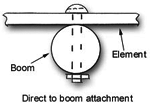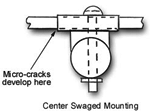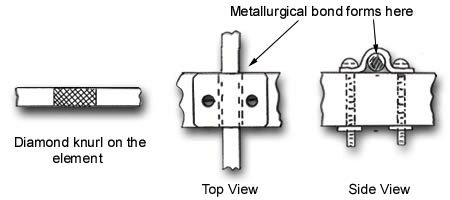One of the most important considerations when designing and building a Yagi antenna is the method used to attach the elements to a boom. This is true because the boom influences the electrical length of the elements. In effect, a boom shields or shorts out that portion of the element where it comes in close proximity with or in direct contact with the boom. In response, the designer must change the physical length of each element. Should the quality of the contact between the elements and the boom change during the life of the antenna, the performance of the system will demonstrably degrade.
The quality of the contact is most often lost due to the buildup of aluminum oxide (an excellent insulator) on the surface where the element and the boom form the contact point. Under stress from wind loads, ice buildup or temperature extremes, elements that are not firmly bonded to the boom will move, creating a gap which will collect moisture and induce the development of aluminum oxide. The loss of contact becomes permanent and the performance of the antenna can be degraded by several dB.
Therefore, in reviewing methods of attachment of elements to the boom, the following points should be remembered:
• The amount of contact area between the element and the boom must be compensated for in the design process
• The mechanical attachment must assure that the contact area remains constant over the life of the antenna, especially in the presence of corrosive environments and mechanical stresses.
• The mechanical attachment process itself should not induce stresses, which will contribute to the failure of the antenna.
The following is an overview of some of the more common attachment methods and the demonstrated performance of each.
CENTER HOLE MOUNTING
One of the earliest element attachment methods was to drill a hole through the center of the element and mount the element directly to the boom, sometimes referred to as the Ohmic contact method. This approach often fails when the element snaps in the center, weakened by the presence of the hole. Contact between the element and the boom is also easily lost as the element bends away from the boom under windy and icy conditions.
CENTER SWAGED MOUNTING
This element mounting method is not reliable because the element
often breaks in half or loses contact with the boom.
Some manufacturers add a swaged on sleeve over the center of the element to strengthen it. However, this approach also has reliability problems. After the element has been subjected to wind and vibration for a period of time (as little as 6 months to a year), the element often breaks off at the edge of the swage point due to metal fatigue caused by micro-cracks developed during the swaging process.
CENTER SCREW MOUNTING
One seemingly simple solution for element mounting is to use a boom made from an insulating material. However, most acceptable boom materials will still have some affect on the electrical performance of the elements. At the same time, the mechanical strength as well as the cost of using a boom material other than aluminum comes into consideration.
Another element mounting method is to drill lateral holes in the boom. The elements are then inserted and centered on the boom. The element is held in place by a hole drilled or tapped through the boom above the element. Then a screw is inserted and tightened until it presses the element in place. However, contact is limited to the two points in the side holes against which the elements are pressed. If the screw tension changes (as it often does), the element is jarred or the boom distorts, oxide will build up in the hole around the element, creating an insulation. This results in a change in the tuning of the element and hence a deterioration in antenna performance.
 SPOT WELDSINSULATOR INSERTS
SPOT WELDSINSULATOR INSERTS
A viable alternative to assuring contact is to eliminate it entirely! To achieve this, a-larger diameter hole is drilled laterally in the boom and an insulating sleeve is inserted and secured. The element is centered in the insulator and fixed in place with small press-on lock rings or “keepers”. The use of inexpensive insulator materials such as nylon can cause failures as the insulator breaks down after exposure to ultra violet radiation, weather extremes, or as it absorbs water, creating a contact where none is desired. High quality insulating materials will drive up the unit cost. The method for fixing the elements in the insulators often fails allowing the elements to physically move and thus impacts performance. Furthermore, the larger holes in the boom can also contribute to a reduction of the mechanical integrity of the antenna.

Spot welding is similar to center screw mounting in that the process establishes limited contact between the element and the boom. The open gap between the element and the holes still creates an environment for the buildup of aluminum oxides. A major manufacturing concern is the tendency of the boom to distort
during the welding process. The designer must compensate for the impact of the distortion by assuring that the design of the antenna is sufficiently robust.
CONTINUOUS WELDS
A continuous weld around the full circumference of the element will minimize the potential of the development of oxides at the contact point. This process is more involved and will increase the unit cost of the antenna. A major concern with welding is the cleaning process, usually caustic, to remove the splashing from the welds. This may cause the boom to etch at a later time.
BRACKET MOUNTING
Antenna Technologies Limited Company has developed a unique process to provide an expanded bonding between the element and the boom thus increasing element to boom conductivity while minimizing mechanical stress during assembly and in the field. The center of the element is knurled to increase its surface area. Then a fitted mounting bracket is placed over the knurled area and attached to the boom using stainless steel hardware. Applying the proper torque to the hardware compresses the knurl into the surface of both the boom and the element mounting bracket and creates an extensive joining surface with excellent conductivity. In essence, a metallurgical bond similar to a cold weld is created. This secures the element in place and minimizes the potential of oxide buildup. Mechanical stress on the element is evenly distributed by the bracket. In turn, the bracket also distributes any stresses across the boom. Furthermore, there are no holes through the element or large boom holes to weaken the structure.
 The electrical impact of the contact area is fully compensated for in the design of the antenna.
The electrical impact of the contact area is fully compensated for in the design of the antenna.
CONCLUSION
The bracket mounting method developed and used by Antenna Technologies Limited Company meets the requirements of quality and durability for mating antenna elements to the boom.
• The clamping action of the bracket, combined with the cold weld effects of the knurl, assures constant maintenance of the contact area, especially during peak load situations such as ice and high winds.
• The mechanical attachment process itself does not impart stresses on the element or seriously degrade the integrity of the boom.
• Antennas produced and field tested using this element mounting process demonstrated excellent electrical performance with no reported failures, even after being subjected to a five (5) year accelerated salt bath.
Antenna Technologies Limited Company and the author retain the rights to all intellectual property contained herein.
This information should be used as a guideline only to help you in the appropriate selection of an antenna.
